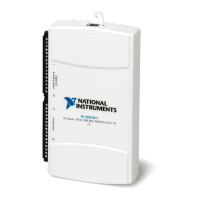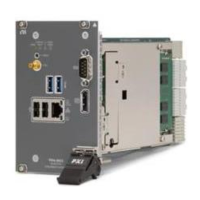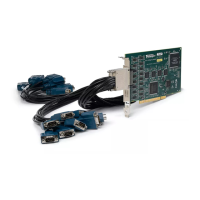© National Instruments | 5-7
NI 6612 User Manual
PCI Express Devices
With the RTSI and PFI buses and the routing capabilities of the NI PCIe-6612, there are several
ways to synchronize multiple devices depending on your application.
To synchronize multiple devices to a common timebase, choose one device—the initiator—to
generate the timebase. The initiator device routes its 10 MHz reference clock to one of the
RTSI <0..7> or PFI <0..15> signals.
Real-Time System Integration (RTSI)
Real-Time System Integration (RTSI) is a signal bus among devices that allows you to do the
following:
• Use a common clock (or timebase) to drive the timing engine on multiple devices
• Share trigger signals between devices
Many National Instruments DAQ, motion, vision, and CAN devices support RTSI.
In a PCI Express system, the RTSI bus consists of the RTSI bus interface and a ribbon cable. The
bus can route timing and trigger signals between several functions on as many as five DAQ,
vision, motion, or CAN devices in the computer.
In a PXI Express system, the RTSI bus is replaced by the PXI and PXI Express trigger signals
on the PXI Express backplane. This bus can route timing and trigger signals between several
functions on as many as seven DAQ devices in the system.
Figure 5-2. NI PCIe-6612 RTSI Pinout
Table 5-4. RTSI Signals
RTSI Bus Signal Terminal
RTSI 7 34
RTSI 6 32
RTSI 5 30
RTSI 4 28
Terminal 2
Terminal 1
Terminal 34
Terminal 33

